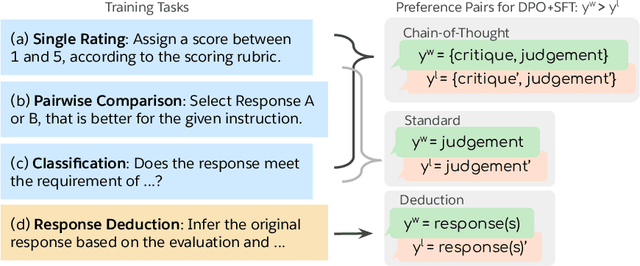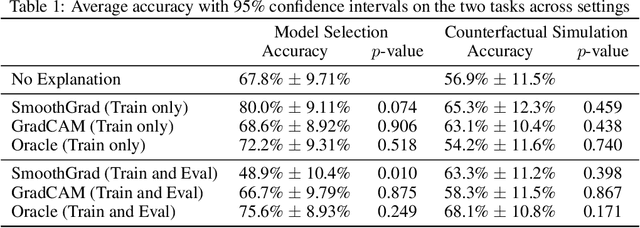Yilun Zhou
Massachusetts Institute of Technology
All for One: LLMs Solve Mental Math at the Last Token With Information Transferred From Other Tokens
Sep 11, 2025Abstract:Large language models (LLMs) demonstrate proficiency across numerous computational tasks, yet their inner workings remain unclear. In theory, the combination of causal self-attention and multilayer perceptron layers allows every token to access and compute information based on all preceding tokens. In practice, to what extent are such operations present? In this paper, on mental math tasks (i.e., direct math calculation via next-token prediction without explicit reasoning), we investigate this question in three steps: inhibiting input-specific token computations in the initial layers, restricting the routes of information transfer across token positions in the next few layers, and forcing all computation to happen at the last token in the remaining layers. With two proposed techniques, Context-Aware Mean Ablation (CAMA) and Attention-Based Peeking (ABP), we identify an All-for-One subgraph (AF1) with high accuracy on a wide variety of mental math tasks, where meaningful computation occurs very late (in terms of layer depth) and only at the last token, which receives information of other tokens in few specific middle layers. Experiments on a variety of models and arithmetic expressions show that this subgraph is sufficient and necessary for high model performance, transfers across different models, and works on a variety of input styles. Ablations on different CAMA and ABP alternatives reveal their unique advantages over other methods, which may be of independent interest.
J4R: Learning to Judge with Equivalent Initial State Group Relative Preference Optimization
May 19, 2025Abstract:To keep pace with the increasing pace of large language models (LLM) development, model output evaluation has transitioned away from time-consuming human evaluation to automatic evaluation, where LLMs themselves are tasked with assessing and critiquing other model outputs. LLM-as-judge models are a class of generative evaluators that excel in evaluating relatively simple domains, like chat quality, but struggle in reasoning intensive domains where model responses contain more substantive and challenging content. To remedy existing judge shortcomings, we explore training judges with reinforcement learning (RL). We make three key contributions: (1) We propose the Equivalent Initial State Group Relative Policy Optimization (EIS-GRPO) algorithm, which allows us to train our judge to be robust to positional biases that arise in more complex evaluation settings. (2) We introduce ReasoningJudgeBench, a benchmark that evaluates judges in diverse reasoning settings not covered by prior work. (3) We train Judge for Reasoning (J4R), a 7B judge trained with EIS-GRPO that outperforms GPT-4o and the next best small judge by 6.7% and 9%, matching or exceeding the performance of larger GRPO-trained judges on both JudgeBench and ReasoningJudgeBench.
Evaluating Judges as Evaluators: The JETTS Benchmark of LLM-as-Judges as Test-Time Scaling Evaluators
Apr 21, 2025Abstract:Scaling test-time computation, or affording a generator large language model (LLM) extra compute during inference, typically employs the help of external non-generative evaluators (i.e., reward models). Concurrently, LLM-judges, models trained to generate evaluations and critiques (explanations) in natural language, are becoming increasingly popular in automatic evaluation. Despite judge empirical successes, their effectiveness as evaluators in test-time scaling settings is largely unknown. In this paper, we introduce the Judge Evaluation for Test-Time Scaling (JETTS) benchmark, which evaluates judge performance in three domains (math reasoning, code generation, and instruction following) under three task settings: response reranking, step-level beam search, and critique-based response refinement. We evaluate 10 different judge models (7B-70B parameters) for 8 different base generator models (6.7B-72B parameters). Our benchmark shows that while judges are competitive with outcome reward models in reranking, they are consistently worse than process reward models in beam search procedures. Furthermore, though unique to LLM-judges, their natural language critiques are currently ineffective in guiding the generator towards better responses.
BingoGuard: LLM Content Moderation Tools with Risk Levels
Mar 09, 2025Abstract:Malicious content generated by large language models (LLMs) can pose varying degrees of harm. Although existing LLM-based moderators can detect harmful content, they struggle to assess risk levels and may miss lower-risk outputs. Accurate risk assessment allows platforms with different safety thresholds to tailor content filtering and rejection. In this paper, we introduce per-topic severity rubrics for 11 harmful topics and build BingoGuard, an LLM-based moderation system designed to predict both binary safety labels and severity levels. To address the lack of annotations on levels of severity, we propose a scalable generate-then-filter framework that first generates responses across different severity levels and then filters out low-quality responses. Using this framework, we create BingoGuardTrain, a training dataset with 54,897 examples covering a variety of topics, response severity, styles, and BingoGuardTest, a test set with 988 examples explicitly labeled based on our severity rubrics that enables fine-grained analysis on model behaviors on different severity levels. Our BingoGuard-8B, trained on BingoGuardTrain, achieves the state-of-the-art performance on several moderation benchmarks, including WildGuardTest and HarmBench, as well as BingoGuardTest, outperforming best public models, WildGuard, by 4.3\%. Our analysis demonstrates that incorporating severity levels into training significantly enhances detection performance and enables the model to effectively gauge the severity of harmful responses.
Direct Judgement Preference Optimization
Sep 23, 2024



Abstract:Auto-evaluation is crucial for assessing response quality and offering feedback for model development. Recent studies have explored training large language models (LLMs) as generative judges to evaluate and critique other models' outputs. In this work, we investigate the idea of learning from both positive and negative data with preference optimization to enhance the evaluation capabilities of LLM judges across an array of different use cases. We achieve this by employing three approaches to collect the preference pairs for different use cases, each aimed at improving our generative judge from a different perspective. Our comprehensive study over a wide range of benchmarks demonstrates the effectiveness of our method. In particular, our generative judge achieves the best performance on 10 out of 13 benchmarks, outperforming strong baselines like GPT-4o and specialized judge models. Further analysis show that our judge model robustly counters inherent biases such as position and length bias, flexibly adapts to any evaluation protocol specified by practitioners, and provides helpful language feedback for improving downstream generator models.
Shared Imagination: LLMs Hallucinate Alike
Jul 23, 2024



Abstract:Despite the recent proliferation of large language models (LLMs), their training recipes -- model architecture, pre-training data and optimization algorithm -- are often very similar. This naturally raises the question of the similarity among the resulting models. In this paper, we propose a novel setting, imaginary question answering (IQA), to better understand model similarity. In IQA, we ask one model to generate purely imaginary questions (e.g., on completely made-up concepts in physics) and prompt another model to answer. Surprisingly, despite the total fictionality of these questions, all models can answer each other's questions with remarkable success, suggesting a "shared imagination space" in which these models operate during such hallucinations. We conduct a series of investigations into this phenomenon and discuss implications on model homogeneity, hallucination, and computational creativity.
A Practical Review of Mechanistic Interpretability for Transformer-Based Language Models
Jul 02, 2024



Abstract:Mechanistic interpretability (MI) is an emerging sub-field of interpretability that seeks to understand a neural network model by reverse-engineering its internal computations. Recently, MI has garnered significant attention for interpreting transformer-based language models (LMs), resulting in many novel insights yet introducing new challenges. However, there has not been work that comprehensively reviews these insights and challenges, particularly as a guide for newcomers to this field. To fill this gap, we present a comprehensive survey outlining fundamental objects of study in MI, techniques that have been used for its investigation, approaches for evaluating MI results, and significant findings and applications stemming from the use of MI to understand LMs. In particular, we present a roadmap for beginners to navigate the field and leverage MI for their benefit. Finally, we also identify current gaps in the field and discuss potential future directions.
MobileAIBench: Benchmarking LLMs and LMMs for On-Device Use Cases
Jun 12, 2024Abstract:The deployment of Large Language Models (LLMs) and Large Multimodal Models (LMMs) on mobile devices has gained significant attention due to the benefits of enhanced privacy, stability, and personalization. However, the hardware constraints of mobile devices necessitate the use of models with fewer parameters and model compression techniques like quantization. Currently, there is limited understanding of quantization's impact on various task performances, including LLM tasks, LMM tasks, and, critically, trust and safety. There is a lack of adequate tools for systematically testing these models on mobile devices. To address these gaps, we introduce MobileAIBench, a comprehensive benchmarking framework for evaluating mobile-optimized LLMs and LMMs. MobileAIBench assesses models across different sizes, quantization levels, and tasks, measuring latency and resource consumption on real devices. Our two-part open-source framework includes a library for running evaluations on desktops and an iOS app for on-device latency and hardware utilization measurements. Our thorough analysis aims to accelerate mobile AI research and deployment by providing insights into the performance and feasibility of deploying LLMs and LMMs on mobile platforms.
CHAMP: A Competition-level Dataset for Fine-Grained Analyses of LLMs' Mathematical Reasoning Capabilities
Jan 13, 2024



Abstract:Recent large language models (LLMs) have shown indications of mathematical reasoning ability. However it has not been clear how they would fare on more challenging competition-level problems. And while self-generated verbalizations of intermediate reasoning steps (i.e., chain-of-thought prompting) have been shown to be helpful, whether LLMs can make use of helpful side information such as problem-specific hints has not been investigated before. In this paper, we propose a challenging benchmark dataset for enabling such analyses. The Concept and Hint-Annotated Math Problems (CHAMP) consists of high school math competition problems, annotated with concepts, or general math facts, and hints, or problem-specific tricks. These annotations allow us to explore the effects of additional information, such as relevant hints, misleading concepts, or related problems. This benchmark is difficult, with the best model only scoring 58.1% in standard settings. With concepts and hints, performance sometimes improves, indicating that some models can make use of such side information. We further annotate model-generated solutions for their correctness. Using this corpus, we find that models often arrive at the correct final answer through wrong reasoning steps. In addition, we test whether models are able to verify these solutions, and find that most models struggle. The dataset and code are available on the project website.
Evaluating the Utility of Model Explanations for Model Development
Dec 10, 2023



Abstract:One of the motivations for explainable AI is to allow humans to make better and more informed decisions regarding the use and deployment of AI models. But careful evaluations are needed to assess whether this expectation has been fulfilled. Current evaluations mainly focus on algorithmic properties of explanations, and those that involve human subjects often employ subjective questions to test human's perception of explanation usefulness, without being grounded in objective metrics and measurements. In this work, we evaluate whether explanations can improve human decision-making in practical scenarios of machine learning model development. We conduct a mixed-methods user study involving image data to evaluate saliency maps generated by SmoothGrad, GradCAM, and an oracle explanation on two tasks: model selection and counterfactual simulation. To our surprise, we did not find evidence of significant improvement on these tasks when users were provided with any of the saliency maps, even the synthetic oracle explanation designed to be simple to understand and highly indicative of the answer. Nonetheless, explanations did help users more accurately describe the models. These findings suggest caution regarding the usefulness and potential for misunderstanding in saliency-based explanations.
 Add to Chrome
Add to Chrome Add to Firefox
Add to Firefox Add to Edge
Add to Edge